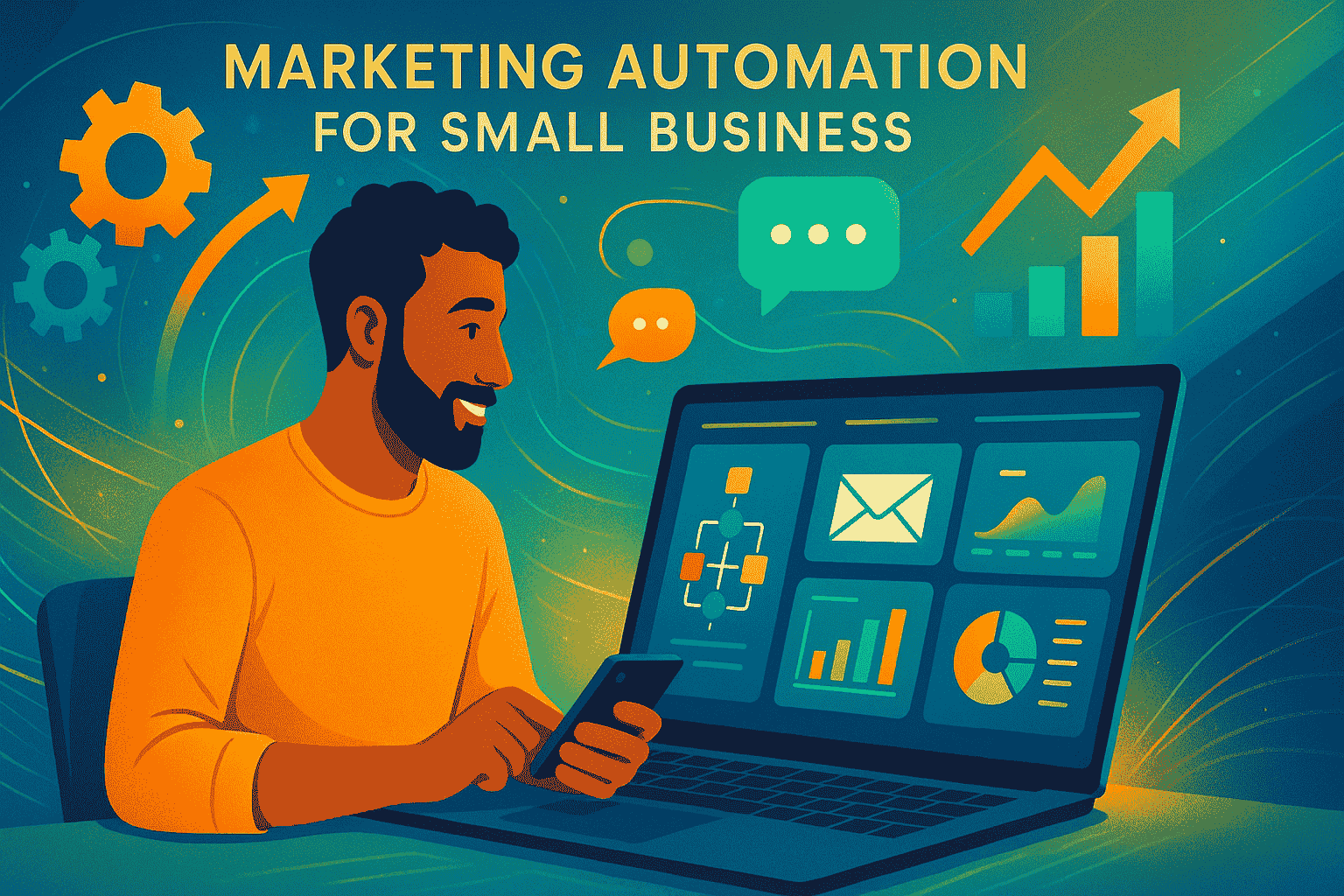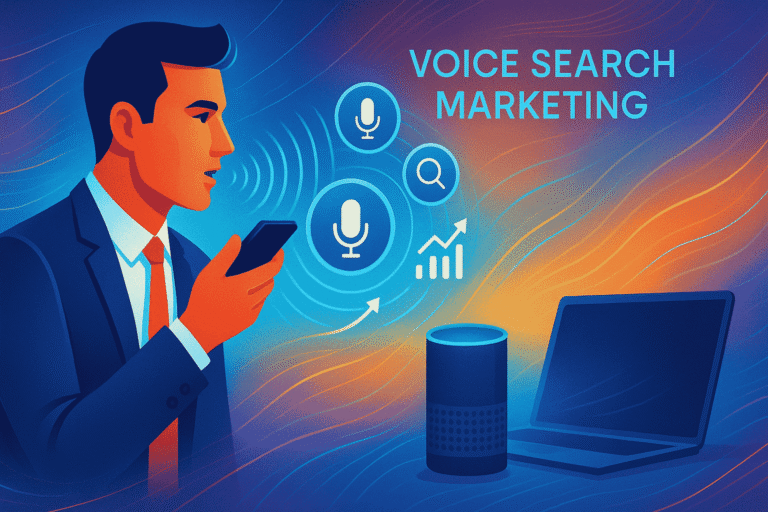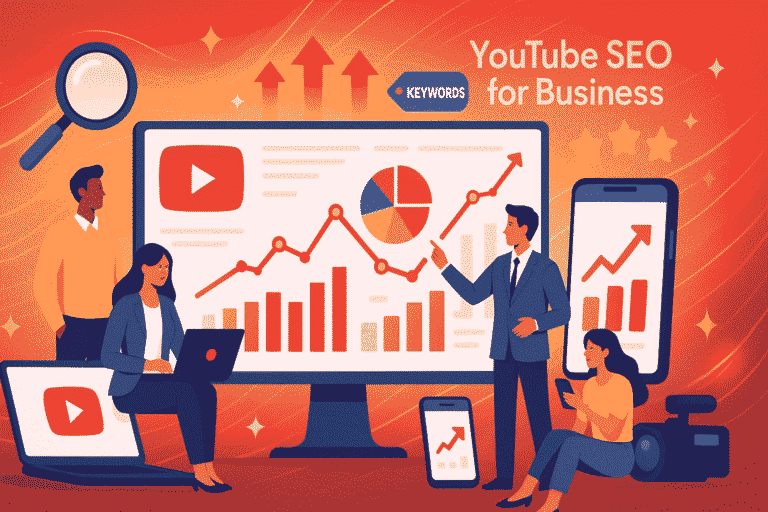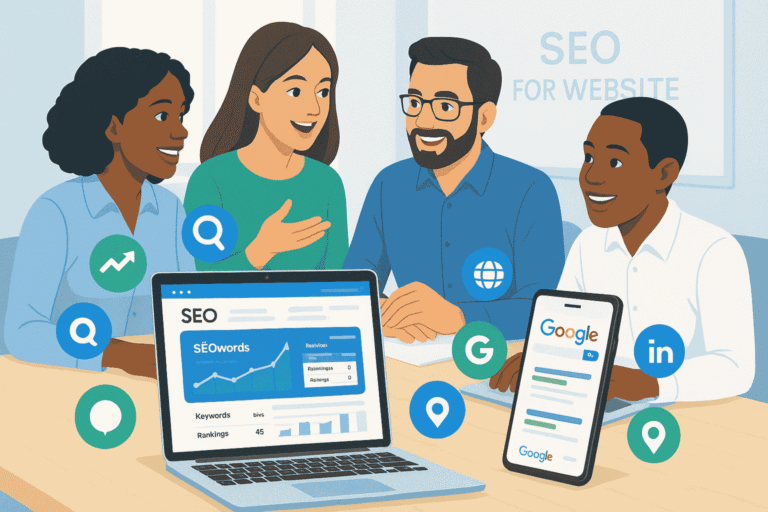Marketing automation for small business is no longer just for big brands. In 2025, automation tools are affordable, easy to use, and essential for any small business that wants to compete, save time, and grow faster. But what exactly is marketing automation, and how can it transform your business?
This ultimate guide will show you how marketing automation for small business can help you attract more leads, nurture relationships, and boost sales—without burning out or breaking the bank.
What is Marketing Automation for Small Business?
Marketing automation for small business means using software to automate repetitive marketing tasks like email campaigns, social media posting, lead nurturing, and customer follow-ups. Instead of doing everything manually, you set up workflows that run in the background—so you can focus on what matters most.
Key benefits:
- Save time and reduce manual work
- Personalize customer experiences at scale
- Nurture leads automatically
- Increase sales and customer retention
- Track and measure marketing ROI
Why Marketing Automation for Small Business Matters in 2025
The digital landscape is more competitive than ever. Here’s why marketing automation for small business is essential:
- Efficiency: Automate repetitive tasks and free up time for strategy and growth.
- Personalization: Deliver the right message to the right person at the right time.
- Scalability: Grow your business without hiring a huge team.
- Data-Driven Decisions: Use analytics to optimize every campaign.
- Customer Experience: Provide fast, relevant, and consistent communication.
According to Salesforce, businesses using marketing automation see a 451% increase in qualified leads.
7 Powerful Ways Marketing Automation Helps Small Businesses Grow
1. Automated Email Campaigns
Send welcome emails, product recommendations, and follow-ups automatically based on customer actions.
Example: A new subscriber gets a welcome series, then product tips, then a special offer.
2. Lead Nurturing and Scoring
Automatically move leads through your sales funnel based on their behavior (downloads, clicks, site visits).
Example: Hot leads get sent to sales, cold leads get more educational content.
3. Social Media Scheduling
Plan and schedule posts across Facebook, Instagram, LinkedIn, and more from one dashboard.
Example: Schedule a month’s worth of posts in a single afternoon.
4. Customer Segmentation
Group customers by interests, purchase history, or engagement level for targeted campaigns.
Example: Send VIP customers exclusive offers and re-engage inactive ones with win-back emails.
5. SMS and Messenger Automation
Send appointment reminders, order updates, or flash sales via text or chatbots.
Example: A salon sends automated reminders and fills last-minute openings.
6. Analytics and Reporting
Track open rates, clicks, conversions, and sales in real time.
Example: See which campaigns drive the most revenue and double down on what works.
7. E-commerce Automation
Recover abandoned carts, upsell related products, and request reviews automatically.
Example: An online store sends a discount to shoppers who leave items in their cart.
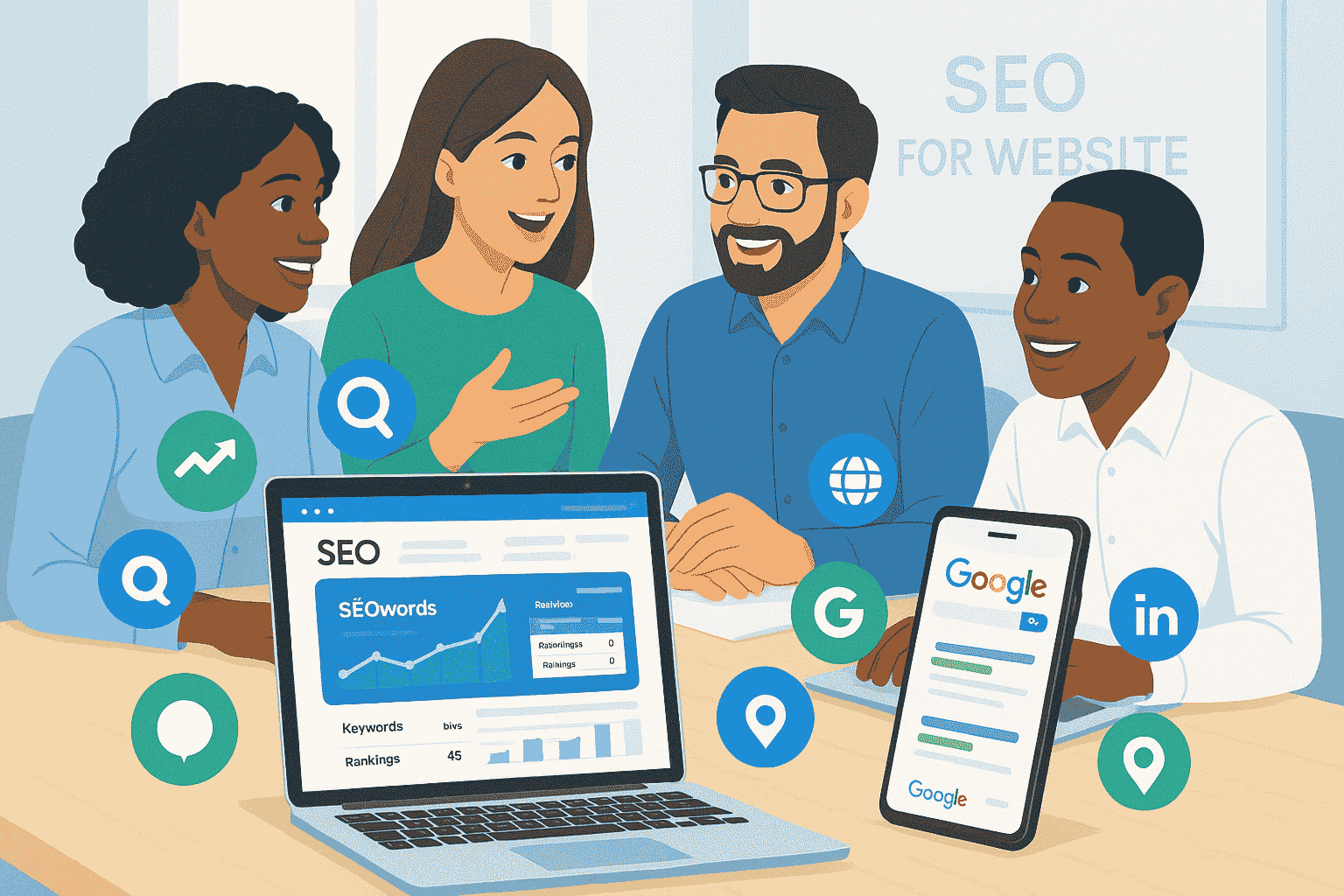
How to Get Started with Marketing Automation for Small Business
1. Choose the Right Tool
Look for platforms like Mailchimp, HubSpot, ActiveCampaign, or Zoho that fit your needs and budget.
2. Map Your Customer Journey
Identify key touchpoints where automation can help (welcome, nurture, purchase, follow-up).
3. Start Simple
Automate one or two workflows first, then expand.
4. Personalize Your Messages
Use names, purchase history, and behavior to make automation feel human.
5. Test and Optimize
Review your analytics and tweak your workflows for better results.
Building a Data-Driven Marketing Automation Strategy
1. Set Clear Goals
Define what you want to achieve: more leads, higher sales, better retention, or improved customer experience.
2. Collect and Integrate Data
Use forms, surveys, and tracking pixels to collect customer data. Integrate your CRM, email, and e-commerce platforms for a unified view.
3. Segment Your Audience
Group your contacts by demographics, behavior, or lifecycle stage. Send targeted messages to each segment.
4. Personalize Every Touchpoint
Use dynamic content, personalized offers, and behavior-triggered messages to increase engagement.
5. Automate Lead Scoring
Assign points based on actions (downloads, clicks, purchases) to identify hot leads and prioritize follow-up.
Marketing Automation for Small Business: Email Campaigns
Email remains the backbone of marketing automation for small business. Here’s how to make it work:
- Welcome Series: Greet new subscribers and introduce your brand.
- Nurture Sequences: Educate leads and move them toward a purchase.
- Abandoned Cart Emails: Recover lost sales with timely reminders.
- Re-engagement Campaigns: Win back inactive subscribers with special offers.
- Post-Purchase Follow-Ups: Request reviews, offer upsells, and build loyalty.
Pro Tip:
Use A/B testing to optimize subject lines, content, and send times.
Social Media Automation for Small Business
Social media can be a time sink. Marketing automation for small business lets you:
- Schedule posts in advance
- Monitor engagement and respond quickly
- Run automated contests and giveaways
- Track performance across platforms
Tools to try:
Buffer, Hootsuite, Later, Sprout Social
SMS and Messenger Automation
Text and chatbots are powerful for instant communication:
- Send appointment reminders and confirmations
- Deliver flash sales and exclusive offers
- Answer FAQs and provide support 24/7
- Collect feedback and reviews
Pro Tip:
Keep messages short, relevant, and always include an opt-out option.
E-commerce Automation for Small Business
E-commerce brands can use marketing automation to:
- Recover abandoned carts with reminder emails or SMS
- Upsell and cross-sell related products
- Send order updates and shipping notifications
- Request reviews and referrals after purchase
- Segment customers by purchase history for targeted offers
Analytics and Reporting: Measuring Success
Track these key metrics to measure the impact of marketing automation for small business:
- Open and click-through rates (email/SMS)
- Conversion rate (leads to sales)
- Customer lifetime value (CLV)
- Cost per acquisition (CPA)
- Return on investment (ROI)
- Unsubscribe and opt-out rates
Action Step:
Set up dashboards to monitor your KPIs and adjust your strategy based on data.
Personalization and Customer Experience
Personalization is the heart of marketing automation for small business:
- Use first names in emails and messages
- Recommend products based on browsing or purchase history
- Send birthday or anniversary offers
- Personalize website content for returning visitors
Pro Tip:
The more relevant your message, the higher your engagement and conversion rates.
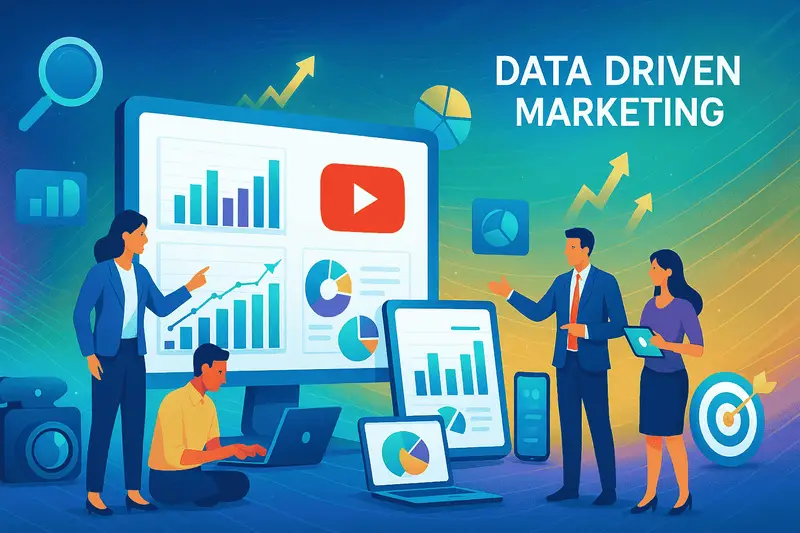
Advanced Marketing Automation Strategies for Small Business
1. Multi-Channel Automation
Combine email, SMS, social, and web push notifications for a seamless customer journey.
2. Behavioral Triggers
Send messages based on user actions (e.g., viewed a product, downloaded a guide, clicked an ad).
3. Lead Scoring and Nurturing
Automatically score leads and move them through your funnel with targeted content.
4. Dynamic Content
Show different offers or messages based on user data and behavior.
5. Integrate with CRM and Sales
Sync marketing automation with your CRM to align sales and marketing efforts.
Common Mistakes in Marketing Automation for Small Business
- Trying to automate everything at once
- Sending generic, non-personalized messages
- Ignoring analytics and not optimizing
- Over-communicating and annoying customers
- Not integrating automation with your CRM or sales tools
- Neglecting mobile optimization
- Failing to segment your audience
- Not testing and iterating workflows
- Ignoring compliance and privacy laws
- Forgetting the human touch
Case Studies: Marketing Automation for Small Business Success
1. Local Retailer: 30% More Sales
A local boutique used marketing automation to send personalized offers and abandoned cart reminders. Sales increased by 30% in three months.
2. Fitness Studio: 50% Higher Retention
A fitness studio automated class reminders and follow-ups, reducing no-shows and boosting membership renewals by 50%.
3. Online Course Creator: 3X More Leads
An online educator used lead magnets and automated nurture sequences to triple their email list and double course sales.
4. Dental Practice: 40% More Appointments
A dental clinic used SMS reminders and automated follow-ups to reduce missed appointments and increase bookings by 40%.
Top Tools for Marketing Automation for Small Business
- Mailchimp: Email automation, segmentation, and analytics
- ActiveCampaign: Advanced automation, CRM, and SMS
- HubSpot: All-in-one marketing, sales, and CRM platform
- Zoho CRM: Affordable automation for small businesses
- Klaviyo: E-commerce automation and personalization
- Buffer/Hootsuite: Social media scheduling and analytics
- ManyChat: Messenger and SMS automation
- Zapier: Connects your favorite apps and automates workflows
The Future of Marketing Automation for Small Business
- AI and Machine Learning: Smarter automation, predictive analytics, and hyper-personalization
- Omnichannel Journeys: Seamless experiences across email, SMS, social, and web
- Voice and Chatbot Integration: Automated voice assistants and conversational marketing
- Privacy-First Automation: Compliance with GDPR, CCPA, and evolving privacy laws
- No-Code Automation: Easy-to-use tools for non-technical users
Marketing Automation for Small Business: Your 2025 Action Plan
- Audit your current marketing processes for automation opportunities.
- Choose the right tools for your needs and budget.
- Map your customer journey and identify key touchpoints.
- Start with one or two automated workflows and expand over time.
- Segment your audience for personalized messaging.
- Test, measure, and optimize your campaigns regularly.
- Stay updated on automation trends and best practices.
Marketing Automation for Small Business: Advanced Strategies for 2025
1. Multi-Channel Automation for Maximum Impact
Modern customers interact with brands across multiple channels—email, SMS, social media, web, and even chatbots. The most successful marketing automation for small business strategies use a multi-channel approach to reach customers wherever they are.
How to implement:
- Use automation tools that integrate email, SMS, and social media scheduling.
- Trigger follow-up emails after a customer clicks a social ad or visits your website.
- Send SMS reminders for appointments, events, or flash sales.
- Use chatbots on your website and Facebook Messenger to answer FAQs and capture leads.
Pro Tip:
Coordinate your messaging across channels for a seamless customer experience. For example, if a customer abandons a cart, send an email reminder, follow up with an SMS, and retarget them with a Facebook ad.
2. Behavioral Triggers and Customer Journeys
Behavioral triggers are the backbone of effective marketing automation for small business. These are automated actions based on what your customers do (or don’t do).
Examples of behavioral triggers:
- Welcome email after a newsletter signup
- Product recommendation after a purchase
- Reminder email if a customer hasn’t visited in 30 days
- Birthday or anniversary offers
- Feedback request after a service is completed
Action Step:
Map out your ideal customer journey and identify key moments where automation can add value.
3. Lead Scoring and Sales Alignment
Not all leads are created equal. Marketing automation for small business allows you to score leads based on their actions and engagement, so your sales team can focus on the hottest prospects.
How lead scoring works:
- Assign points for actions like email opens, link clicks, downloads, and website visits.
- Set a threshold for when a lead is “sales-ready.”
- Automatically notify your sales team or trigger a personalized follow-up when a lead reaches the threshold.
Pro Tip:
Regularly review and adjust your lead scoring model based on what actually leads to sales.
4. Dynamic Content and Personalization
Personalization goes beyond using a customer’s name. With marketing automation for small business, you can show different content, offers, or products based on user data and behavior.
Examples:
- Show different homepage banners to new vs. returning visitors.
- Recommend products based on browsing or purchase history.
- Personalize email content based on location, interests, or past purchases.
Action Step:
Use dynamic content blocks in your emails and landing pages to tailor the experience for each user segment.
5. Automated Customer Feedback and Review Requests
Customer feedback is gold for small businesses. Use marketing automation to:
- Send automated review requests after a purchase or service.
- Trigger surveys to measure customer satisfaction (NPS, CSAT).
- Collect testimonials for your website and social media.
Pro Tip:
Incentivize feedback with a discount or entry into a giveaway.
6. Drip Campaigns and Nurture Sequences
Drip campaigns are a series of automated emails sent over time to educate, nurture, and convert leads.
How to use drip campaigns:
- Welcome series for new subscribers
- Educational series for leads not ready to buy
- Onboarding series for new customers
- Re-engagement series for inactive users
Action Step:
Map out your drip campaigns for each stage of the customer journey and automate them in your marketing platform.
7. Marketing Automation for Small Business: Integrating with CRM
A CRM (Customer Relationship Management) system is the backbone of marketing automation for small business. Integration allows you to:
- Track every interaction with your leads and customers
- Segment your audience for targeted campaigns
- Automate follow-ups and reminders for your sales team
- Measure the full customer lifecycle from lead to loyal customer
Popular CRM integrations:
HubSpot, Salesforce, Zoho CRM, Pipedrive, ActiveCampaign
8. Marketing Automation for Small Business: Analytics and Reporting
Data is the fuel for continuous improvement. Use analytics to:
- Track open rates, click-through rates, and conversions for every campaign
- Identify which channels and messages drive the most revenue
- Monitor customer lifetime value and retention rates
- Test and optimize subject lines, content, and timing
Action Step:
Set up dashboards to monitor your KPIs and review them weekly with your team.

Overcoming Common Challenges in Marketing Automation for Small Business
1. Avoiding Over-Automation
Too much automation can make your brand feel impersonal. Balance automation with human touchpoints—personal calls, handwritten notes, or live chat support.
2. Keeping Your Data Clean
Regularly clean your email lists and CRM to remove duplicates, inactive contacts, and outdated information. This improves deliverability and campaign performance.
3. Ensuring Compliance
Stay up to date with privacy laws like GDPR and CAN-SPAM. Always get consent before sending marketing messages and make it easy to unsubscribe.
4. Training Your Team
Invest in training so your team can use automation tools effectively. Many platforms offer free courses and certifications.
Marketing Automation for Small Business: Industry-Specific Tips
Retail
- Automate loyalty program emails and rewards.
- Send personalized product recommendations based on purchase history.
- Use SMS for flash sales and in-store events.
Service Businesses
- Automate appointment reminders and follow-ups.
- Send satisfaction surveys after each service.
- Nurture leads with educational content about your services.
E-commerce
- Recover abandoned carts with automated emails and SMS.
- Upsell and cross-sell related products post-purchase.
- Request reviews and referrals after delivery.
B2B
- Nurture leads with educational drip campaigns.
- Score leads based on engagement and trigger sales follow-ups.
- Automate webinar invites and follow-ups.
The Human Side of Marketing Automation for Small Business
While automation saves time and increases efficiency, don’t forget the human element:
- Personalize your messages with real names and relevant content.
- Use automation to free up time for personal outreach and relationship building.
- Monitor responses and jump in with a personal touch when needed.
Pro Tip:
Always offer a way for customers to reach a real person if they have questions or need help.
Marketing Automation for Small Business: Your 2025 Success Checklist
- Audit your current marketing processes for automation opportunities.
- Choose the right tools for your needs and budget.
- Map your customer journey and identify key touchpoints.
- Start with one or two automated workflows and expand over time.
- Segment your audience for personalized messaging.
- Test, measure, and optimize your campaigns regularly.
- Stay updated on automation trends and best practices.
- Balance automation with human connection for the best results.
Final Thoughts
Marketing automation for small business is more than just a trend—it’s a proven way to save time, boost sales, and deliver better customer experiences. By combining the right tools, strategies, and a human touch, you can compete with larger brands and grow your business in 2025 and beyond.
Ready to take your marketing to the next level? Start building your marketing automation strategy today and watch your business thrive!
Conclusion
Marketing automation for small business is a powerful way to save time, boost sales, and deliver better customer experiences. Start small, focus on your biggest pain points, and let automation help you grow in 2025 and beyond.
Frequently Asked Questions
Q: Is marketing automation expensive for small businesses?
A: Many tools offer affordable plans, and the ROI from time saved and increased sales often outweighs the cost.
Q: Can I automate social media and email together?
A: Yes! Most platforms let you automate across multiple channels for a seamless customer journey.
Q: How do I avoid sounding robotic in my automated messages?
A: Personalize your content, use natural language, and always offer a way to connect with a real person.
Q: What’s the biggest mistake in marketing automation for small business?
A: Trying to automate everything at once or sending generic, non-personalized messages.
Further Reading
- Salesforce: What is Marketing Automation?
- HubSpot: Marketing Automation Guide
- Mailchimp: Marketing Automation for Small Business
- Neil Patel: Marketing Automation Tips
Need Help Elevating Your Digital Brand?
Ready to implement a future-ready brand strategy? Our expert team specializes in crafting compelling online identities that convert browsers into believers.
👉 Contact Us Today for a free 15-minute consultation.

